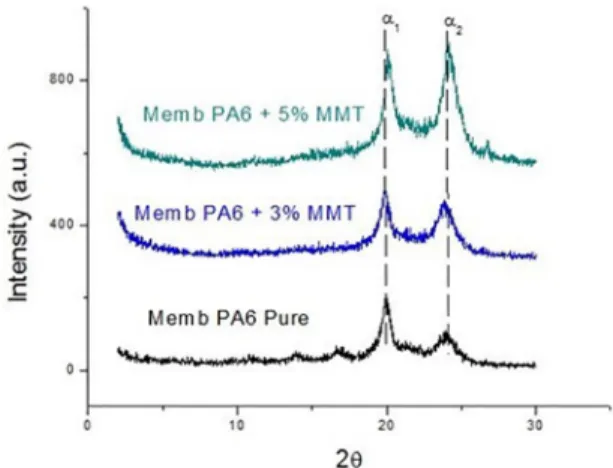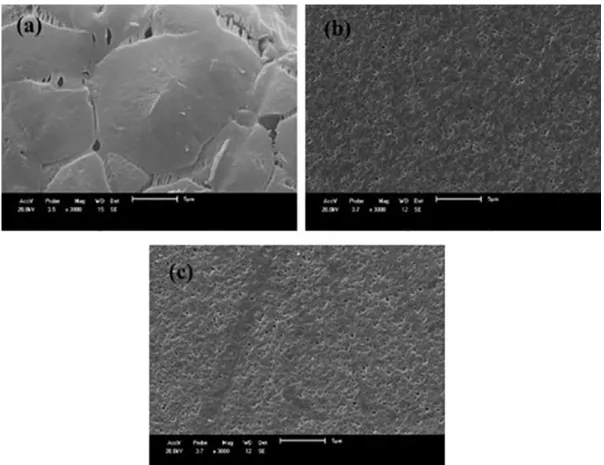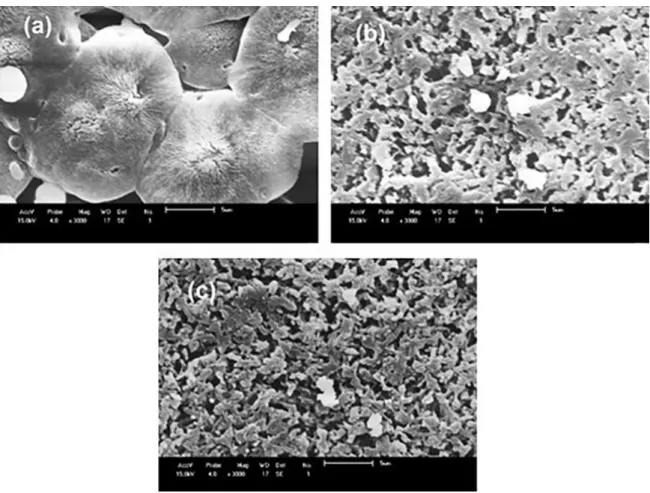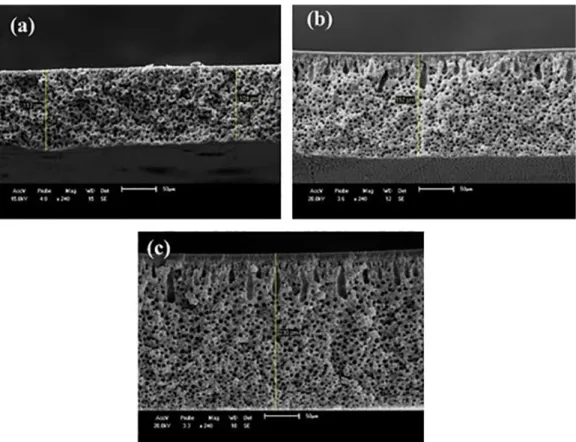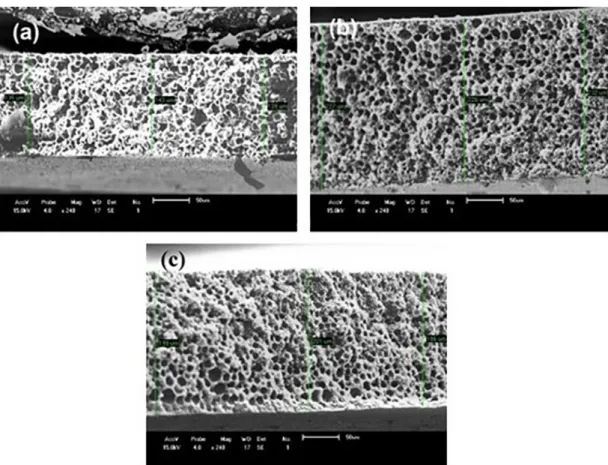Coagulation Bath in The Production of Membranes of Nanocomposites Polyamide 6/Clay
Rodholfo Silva Barbosa Ferreiraa*, Caio Henrique do Ó Pereiraa, Edson Antônio dos Santos Filhoa, Amanda Melissa Damião Leiteb, Edcleide Maria Araújoa, Hélio de Lucena Liraa
Received: April 29, 2017; Revised: November 19, 2017; Accepted: December 07, 2017
Membranes of polyamide 6 and its nanocomposites with 3 and 5% of clay were obtained by the phase inversion method using distilled water and solvent as the coagulation bath, 10 and 30% of acid was used, in order to change the membranes morphology/porosity. By XRD analysis, the obtained nanocomposites showed an exfoliated and/or partially exfoliated structure, it was also seen two
characteristics peaks of the polyamide 6 phases (α and γ). For the membranes, the characteristic peak γ of the membrane disappeared, being evident the peaks α1 and α2. By SEM the PA6 membrane almost doesn't have pores in its surface, with an addition of clay had an increase in the quantity of surface pores. In the cross section of the PA6 membrane, an extremely thin selective layer, adding the clay
the selective layer became thicker and a better defined porous support was obtained. From the acid in the coagulation bath the PA6 membrane continued with a few pores structure. For the nanocomposites
there was an increase in size and a better uniformity of the pores. In the cross section the presence of
the bath decrease the membrane filtering, also modifying a uniformity of the pores.
Keywords: membrane, nanocomposite, polyamide 6, clay, coagulation bath
*e-mail: rodholfoferreira@gmail.com
1. Introduction
Membranes are filter media, which are usually produced from polymeric material, which have pores with different
dimensions. The pores are responsible for the various properties that can make them viable for a particular application, both
to separate particles and to fractionate molecules of different
molar masses. The membranes can act as a selective barrier
like a filter, they can separate materials that with a regular filter would not be possible because it lacks adequate capacity
for this type of process1,2.
The phase inversion is the method that is being very used to obtain polymeric membranes, which a polymer
solution is spread as a thin film on a glass plate or extruded as a hollow fiber, and then precipitated in a non-solvent
bath3-5. The membrane is formed by the destabilization of the solution and the polymer precipitation. This technique allows large morphological change from small variations made in parameters used during the membranes preparation process6. This process allows to obtain membranes with a wide variety of morphology and a large number of applications. The polymeric membranes have several advantages, and they have been used in various applications in industrial
processes, such as in processes of separation, purification
and fractionation of various industrial branches3,7. The main processes in which membranes are being used are
microfiltration (MF), ultrafiltration (UF), nanofiltration (NF),
reverse osmosis (HI), dialysis (D), gas permeation (GP) and pervaporation (PV). The efficiency and application of the
membranes will depends on the morphology that it will present and as well as the nature of the material that constitutes8-10.
For greater efficiency in production and application of the membranes, the surface modification is an approach that
has been widely exploited to improve the fouling resistance
in water purification from membranes. Thus, it is necessary
to introduce an agent that can improve the characteristics and
efficiency of the membrane, such as the inorganic fillers11. Polyamides are materials of fatigue resistance, high tensile strength, abrasion and good toughness. These properties is improved with the addition of clay when compared to pure polymer12,13. Polyamide membranes offer the advantage of being a hydrophilic material, and for this reason do not
require a wetting agent used in applications microfiltration14-16. In recent years, polymer nanocomposites have caused great interest from both industry and academia17-19, as they are hybrid materials in which particles of nanometric dimensions are dispersed in a single polymer matrix20. The reinforced
polymers with low percentages mass of clay (1-5%) have
raised interest in academic and industrial environment, due to considerable improvement of physical and mechanical properties, in addition to allow processing from conventional techniques such as extrusion and/or injection21.
Nanocomposite materials are systems that have a polymeric matrix and a second inorganic phase (not
aLaboratório de Desenvolvimento de Membranas, Universidade Federal de Campina Grande, Campina
Grande, PB, Brazil
bEscola de Ciências e Tecnologia - EC&T, Universidade Federal do Rio Grande do Norte, Natal, RN,
The addition of inorganic nanoparticles (clay) considerably improves the filtration of membrane controlling the formation
and growth of macrovoids, increasing the number of small pores improving hydrophilicity, porosity, permeability, mechanical properties and antifouling properties22,24,25.
Teimoori26 studied the impact of several alkanes as additives in coagulation bath, on the structural parameters and
the morphologies of flat PES membranes. The asymmetric
membranes was also fabricated by phase inversion method. It was expected that two distinct phase inversions to be occurred since both the polymer and the additives were insoluble in the coagulation bath. In conclusion, it was revealed that the coagulation bath had a major impact on the membranes structure in order to achieve the enhanced properties.
Taking into consideration what were exposed, the objective of this work is to study the addition of acid in the coagulation bath in the morphology of membranes of polyamide 6 and its nanocomposites.
2. Materials and Methods
2.1 Materials
The polymer matrix used was polyamide 6 Polyform B300, viscosity IV = 140-160 mL/g as white colored granules. The clay used was Brasgel PA, with cation exchange capacity
(CEC) of 90meq / 100g, supplied by Bentonit União Nordeste, located in the city of Campina Grande - PB, in the form of powder, used as nanofiller. To obtain the membranes the
formic acid was used with 99% purity, and for the coagulation bath the acid with 85% purity, both made by Vetec.
2.2 Methods
Initially all materials containing polyamide 6 were dried in a vacuum oven for a period of 24 hours at 80ºC.
To obtain nanocomposites of polyamide 6/clay, a polymer/
clay concentrate (1:1) by mass was obtained using a high speed
homogenizer, model MH-50H of the brand MH Equipamentos. The obtained concentrate was ground and incorporated into the polyamide 6 matrix in amounts representing nominal of
3 and 5% contents, in weight, of clay in a Werner-Pfleiderer
ZSK 18 twin-screw extruders, with L/D 40 mm, with screw
rotation speed of 250 rpm and temperature profile of 260 ºC for all zones. Figure 1 illustrates the extruder screw profile
used for the production of nanocomposites.
For the membranes preparation by the phase inversion
method, polyamide 6 and its nanocomposites were dissolved
in formic acid (99% purity) in a proportion of 20:80% by
dried at room temperature. This procedure is in accordance with the literature27.
The membranes were also obtained using a precipitation
bath containing distilled water and formic acid (85% purity) with different contents (20 and 30%), the procedure has
already been described previously.
2.3 Characterizations
The polymer nanocomposites and membranes were
characterized by X-ray diffraction (XRD), using a Shimadzu XRD 6000 equipment, with CuKα radiation (λ = 1.5418 Å), 40 kV, 30 mA, and scanning 2θ from 1.5º to 30º at a
scanning rate of 2º/min. The membranes were characterized by scanning electron microscopy analyzes were performed on a Superscan - Shimadzu SSX 550 equipment, operating at 15kV. The surface and cross-section of the membranes were
evaluated. For the cross section analyzes, the samples were
fractured in liquid nitrogen to prevent plastic deformation. The surfaces of the samples were coated with gold, in order to avoid the accumulation of negative charge. The thickness and the pore sizes measurements of the surface and cross-section of the membranes were made on the equipment itself.
3. Results and Discussion
Figure 2 illustrates the results from X-ray diffraction of
clay, polyamide 6 and the nanocomposites with contents of 3 and 5% of clay mass.
It is noticed that the characteristic peak of the clay disappears when it is incorporated to the polymeric matrix, presenting an exfoliated and/or partially exfoliated structure29 indicating that a nanocomposite with this type of structure was obtained.
It can also be seen the presence of two peaks in the range
of 2θ = 20 º and 23 º, corresponding to reflections related to the crystalline planes (200) and (002) of the α phase of
polyamide 6. In the literature, these crystalline planes were also observed27,28,30,31. It is possible to observe that the PA6
curve presents a behavior slightly different from the other curves, with the appearance of the crystalline plane (001) corresponding to the phase γ of the polymer. According to32 the polyamide 6 can assume two crystallographic forms,
monoclinic α and monoclinic or pseudo-hexagonal γ. Figure 3 shows the XRD diffractograms of membranes
prepared from polyamide 6 and its nanocomposites. As in
Figure 2, the absence of the characteristic peak of the clay
SEM images of the surfaces of PA6 membranes and their nanocomposites with and without a coagulation bath
are shown in Figures 4 to 6. The PA6 membrane has a dense
structure and a small number of pores. It is also observed that the presence of clay with contents of 3 and 5% in the membranes of PA6 provided a greater amount of pores and a better distribution throughout the surface. Increasing the percentage of clay also increased the amount of pores. Thus, it was evident the presence of the clay changes the quantity and uniformity of the pores. As observed by Medeiros35, the
addition of clay particles in the membrane structure modifies
the pore morphology on the membrane surface.
With the presence of 10% of formic acid in the precipitation
bath (Figure 5), it is observed that the PA6 continues to
have a dense structure. In the nanocomposite membranes, the pores became larger and irregularly shaped, being this more pronounced for the membrane with 5% of clay, when compared to the membranes without the presence of acid
in the precipitation bath of Figure 4.
For the precipitation bath containing 30% of formic acid, Figure 6, the PA6 membrane continued to have a
dense structure, but there was an increase in the pores size presents on the surface. Membranes obtained with 3 and 5% of MMT had a morphology similar to that seen in the membranes with 10% of acid. However, the pores were larger, but less uniform in all the surface of the membrane. Thus, the introduction of 10% formic acid favored a better pores size uniformity.
For membranes produced with 10% and 30% solvent,
it was possible to observe the presence of white particles throughout the membrane porous support, where this can be due to the poor dissolution of the polymer.
In Table 1 we have the pore size values for the membrane
surface produced from the three different modes. Initially it was seen that clay had a direct influence on the size and
distribution of membrane pores. The clay acted as a porogenic agent, increasing the amount of pores but decreasing the size of the pores throughout the membrane surface. With the presence of the acid, there was an increase in the pore size of the membranes containing clay, being attributed to a possible interaction between MMT and formic acid.
Figures 7 to 9 show the cross sections images of the
PA6 membranes and their nanocomposites.
It was observed that, in general, the obtained membranes presented an asymmetric morphology formed by a selective Figure 1. Extruder screw profile.
Figure 2. XRD patterns of clay, PA6 and its nanocomposites with different clay content (3 and 5%)
Figure 3. XRD patterns of the membranes PA6 and its nanocomposites with different clay content (3 and 5%)
Unlike the nanocomposites, the membranes presented an important characteristic in the diffractograms. It can be observed the presence of the phases α1 and α2 with more intensity for all the membranes produced33. In Figure 2, it is almost impossible to visualize the presence of these two
crystalline phases of polyamide 6, and it is possible to affirm that the presence of formic acid influenced the crystallinity of the polymer, also making the phase γ disappear in the
membranes, due to the solvent that changed the crystalline character of the material. The appearance of both peaks is
related to the formation of two different crystallographic forms (α1 and α2) of the polyamide
Figure 4. SEM images of the membranes surface of: (a) PA6; (b) PA6 + 3% MMT; and (c) PA6 + 5% MMT
Figure 5. SEM images of the membranes surface with precipitation bath with 10% of formic acid: (a) PA6; (b) PA6
Figure 6. SEM images of the membranes surface with precipitation bath with 30% of formic acid: (a) PA6; (b) PA6 + 3% MMT and (c)
PA6 + 5% MMT
Table 1. Pore size at the surface to all the membranes produced.
Membranes No bath 10% acid 30% acid
PA6 1,161 µm 0,874 µm 1,632 µm
PA6 + 3% 0,304 µm 0,336 µm 0,679 µm
PA6 + 5% 0,277 µm 0,471 µm 0,673 µm
layer and a porous support, this structures is characteristic of the technique of obtaining the membranes that was the inversion of phases. It is possible to observe that the PA6 membranes presented a thin selective layer and the porous support with uniform and interconnected pores. The membranes with 3 and
5% of clay contents presented a better defined selective layer
and a support with the presence of "fingers" interconnected and very close to the selective layer, these pores can be related to a possible delayed precipitation as a function of the presence of clay in the polymer solution. The "fingers" can also be related to the presence of a larger volume of trapped gases in the polymer solution, probably occurring a slower precipitation when were obtained these membranes36.
The clay also influenced the regularity and the shape of the
porous, leaving them more spherical. The PA6 membranes and its nanocomposites had a total thickness of 109, 152 and 230 µm respectively, also having an increase in the thickness of the
selective layer. In view of this, it can be observed that the presence
of clay significantly changed the morphology of the membranes.
The structure analysis of a membrane through the cross section is as determinant as the top surface, since it is responsible for the productivity of the membrane, where it will determine the permeability characteristics of it37.
With the presence of 10% of formic acid in the
precipitation bath, Figure 8, the PA6 membrane presented a decrease of the filtering skin in relation to PA6 membrane without the presence of acid, showing the influence of it. For
Figure 7. SEM cross-sectional images of the membranes of: (a) PA6; (b) PA6 + 3%MMT; and (c) PA6 + 5%MMT
Figure 8. SEM cross-sectional images of the membranes with precipitation bath with 10% of formic acid: (a) PA6; (b) PA6
Figure 9. SEM cross-sectional images of the membranes with precipitation bath with 30% of formic acid: (a) PA6; (b) PA6 +
3%MMT and (c) PA6 + 5%MMT
In the precipitation bath with 30% of formic acid,
Figure 9, it was visible that for all the membranes the filter skin reduced significantly, being confused with the porous
support. There was an increase in size and as well in the uniformity of the pores throughout the porous support for the three membranes under study. In those that contain clay it was observed the absence of the "fingers", due to the large
percentage of acid in the bath, showing the direct influence
of it on the formation of this macropore when compared to
the membranes produced with 10% acid (Figure 8)38. It was also possible to visualize that the presence of clay left the pores with more spherical appearance and smaller for the content of 30% of acid.
With these parameters studied it was possible to evaluate that the clay and the presence of the acid in the coagulation bath provided changes in the membrane morphology. The presence of the acid changes the solvent output and the non-solvent input, so the membrane does not form a thick selective layer as in the membranes produced without the coagulation bath, leaving the membrane completely porous. It was clearly seen that the addition of clay in the polymer
matrix significantly changed the amount and uniformity of
the pores, acting as a porogen, as can be observed by Leite23.
4. Conclusions
The influence of different acid levels in the coagulation
bath on the membranes morphology was investigated. Based on the results obtained and presented in this study, it was seen that by XRD possibly nanocomposites were obtained with exfoliated and/or partially exfoliated structures, as
well as the presence of characteristic peaks of the α and γ phases was observed, and also that the nanocomposites
formation altered the crystallinity of polyamide 6. By SEM,
it was evident that the clay directly influenced the formation
and morphology of pores on the membrane surface, when compared to the polyamide 6 membrane, occurring the appearance of macropores in "fingers" shapes. With the presence of formic acid in the bath, it was possible to
visualize a significant change in the formation and also in
size of the membrane surface pores, where the reduction of the membrane selective layer occurred, there was a
decrease in the number of fingers on the porous support
and also an increase in size of the pores interconnected to
the filtering skin.
6. References
1. Dias T. Membranas: Meio Filtrante de Tecnologia Avançada. Revista e Portal Meio Filtrante. 2006;23. Available from: http://www. meiofiltrante.com.br/edicoes.asp?id=258&link=ultima&fase=C. Access in: 18/12/2017.
2. Leite AMD, Araújo EM, Lira HL, Paz RA, Medeiros VN. Obtenção de membranas microporosas a partir de nanocompósitos e poliamida 6/argila nacional. Parte 2: avaliação microestrutural e de permeabilidade das membranas obtidas. Polímeros. 2014;24(1):72-79.
3. Poletto P, Duarte J, Lunkes MS, Santos V, Zeni M, Meireles CS, et al. Avaliação das características de transporte em membranas de poliamida 66 preparadas com diferentes solventes. Polímeros. 2012;22(3):273-277.
4. Belliacanta T, Poletto P, Thürmer MB, Duarte J, Toscan A, Zeni M. Preparação e Caracterização de Membranas Poliméricas a partir da Blenda Polisulfona/Poliuretano. Polímeros.
2011;21(3):229-232.
5. Miller DJ, Paul DR, Freeman BD. An improved method for surface modification of porous water purification membranes.
Polymer. 2014;55(6):1375-1383.
6. Brami MV, Oren Y, Linder C, Bernstein R. Nanofiltration properties of asymmetric membranes prepared by phase inversion of sulfonated nitro-polyphenylsulfone. Polymer. 2017;111:137-147.
7. Nadour M, Boukraa F, Ouradi A, Benaboura A. Effects of Methylcellulose on the Properties and Morphology of Polysulfone Membranes Prepared by Phase Inversion. Materials Research. 2017;20(2):339-348.
8. Habert AC, Borges CP, Nóbrega R. Processo de Separação com Membranas. 1ª ed. Rio de Janeiro: E-papers Serviços
Editoriais; 2006.
9. Araújo JA, Soares MM, Silva SFL, Casqueira RG, Costa DA. Membranas poliméricas de PE-g-MA-Al/AlPO4 impregnado com
Fe, Al - utilização na recuperação de efluentes de galvanoplastia.
Polímeros. 2014;24(1):101-109.
10. Hong A, Fane AG, Burford R. Factors affecting membrane coalescence of stable oil-in-water emulsions. Journal of Membrane Science. 2003;222(1-2):19-39.
11. Liang CY, Uchytil P, Petrychkovych R, Lai YC, Friess K, Sipek M, et al. A comparison on gas separation between PES (polyethersulfone)/MMT (Na-montmorillonite) and PES/ TiO2 mixed matrix membranes. Separation snd Purification Technology. 2012;92:57-63.
12. Anadão P. Ciência e Tecnologia de Membranas. São Paulo:
ArtLiber; 2010.
348.
15. Xu J, Feng X, Gao C. Surface modification of thin-film-composite polyamide membranes for improved reverse osmosis performance.
Journal of Membrane Science. 2011;370(1-2):116-123.
16. Huang L, McCutcheon JR. Hydrophilic nylon 6,6 nanofibers supported thin film composite membranes for engineered osmosis. Journal of Membrane Science. 2014;457:162-169.
17. Paiva LB, Morales AR, Diaz FRV. Argilas organofílicas: características, metodologias de preparação, compostos de intercalação e técnicas de caracterização. Cerâmica. 2008;54(330):213-226.
18. Carisuelo JP, Gavara R, Hernández-Muñoz P. Diffusion modeling in polymer-clay nanocompósitos for food packaging applications throgh finite element analysis of TEM images.
Journal of Membrane Science. 2015;482:92-102.
19. Burgos-Mármol JJ, Patti A. Unveiling the impact of nanoparticle size dispersity on the behavior of polymer nanocomposites.
Polymer. 2017;113:92-104.
20. Wang XL, Qian HJ, Chen LJ, Lu ZY, Li ZS. Dissipative particle dynamics simulation on the polymer membrane formation by immersion precipitation. Journal of Membrane Science. 2008;311(1-2):251-258.
21. Pfaendner R. Nanocomposites: industrial opportunity or challenge?
Polymer Degradation and Stability. 2010;95(3):369-373.
22. Ray SS, Okamoto M. Polymer/layered silicate nanocomposites: a review from preparation to processing. Progress in Polymer Science. 2003;28(11):1539-1641.
23. Leite AMD, Araújo EM, Lira HL, Barbosa R, Ito EN. Obtenção de membranas microporosas a partir de nanocompósitos e poliamida 6/argila nacional. Parte 1: influência da presença da argila na morfologia das membranas. Polímeros. 2009;19(4):271-277.
24. Yang Y, Wu J, Zheng Q, Chen X, Zhang H. The research of rheology and thermodynamics of organic-inorganic hybrid membrane during the membrane formation. Journal of Membrane Science. 2008;311(1-2):200-207.
25. Liu F, Hashim NA, Liu Y, Abed MRM, Li K. Progress in the production and modification of PVDF membranes. Journal of Membrane Science. 2011;375(1-2):1-27.
26. Teimoori M, Hashemifard SA, Ismail AF, Abbasi M. The impact of nonpolar coagulation bath-immiscible liquid additives on the polyethersulfone membranes structure and performance.
Journal of Applied Polymer Science. 2017;134(8):44509.
28. Fornes TD, Paul DR. Crystallization behavior of nylon 6 nanocomposites. Polymer. 2003;44(14):3945-3961.
29. Loo LS, Gleason KK. Investigation of polymer and nanoclay orientation distribution in nylon 6/montmorillonite nanocomposite.
Polymer. 2004;45(17):5933-5939.
30. Hu X, Zhao X. Effects of annealing (solid and melt) on the time evolution of polymorphic structure of PA6/silicate nanocomposites. Polymer. 2004;45(11):3819-3825.
31. Medeiros KM, Silva TRG, Morais DDS, Kojuch LR, Araújo EM, Lira HL. Study of Morphology Membrane of Polymeric Nanocomposites Obtained by Phases Inversion. Materials Science Forum. 2014;775-776:498-503.
32. Khanna YP, Khun WP. Measurement of crystalline index in nylons by DSC: Complexities and recommendations. Journal of Polymer Science. 1997;35(14):2219-2231.
33. Maia LF, Leite AMD, Araújo EM, Lira HL, Paz RA. Spectroscopic and Diffractional Characteristics of Membranes and Polyamide 6/Regional Bentonite Clay Nanocomposites. Materials Science Forum. 2014;775-776:168-172.
34. Leite AMD, Medeiros KM, Araújo EM, Maia LF, Lira HL, Paz RA. Membranes from Nylon 6/Regional Bentonite Clay Nanocomposites.
Materials Science Forum. 2010;660-661:784-787.
35. Medeiros KMD, Araújo EM, Lira HDL, Lima DDF, Lima CAPD. Hybrid Membranes of Polyamide Applied in Treatment of Waste Water. Materials Research. 2017;20(2):308-316.
36. Leite AMD, Maia LF, Paz RA, Araújo EM, Lira HL. Thermal properties from membrane of polyamide 6/montmorillonite clay nanocomposites obtained by immersion precipitation method.
Journal of Thermal Analysis and Calorimetry. 2009;97:577-580.
37. Cunha CTC. Desenvolvimento de Membranas a partir de Blendas de PA6/PEAD/Compatibilizantes. [Dissertation]. Campina Grande:
Universidade Federal de Campina Grande; 2011.
38. Yam-Cervantes MA, Santiago-García JL, Loría-Bastarrachea MI, Duarte-Aranda S, Ruiz-Treviño FA, Aguilar-Vega, M. Sulfonated polyphenylsulfone asymmetric membranes: Effect of coagulation bath (acetic acid-NaHCO3/isopropanol) on
